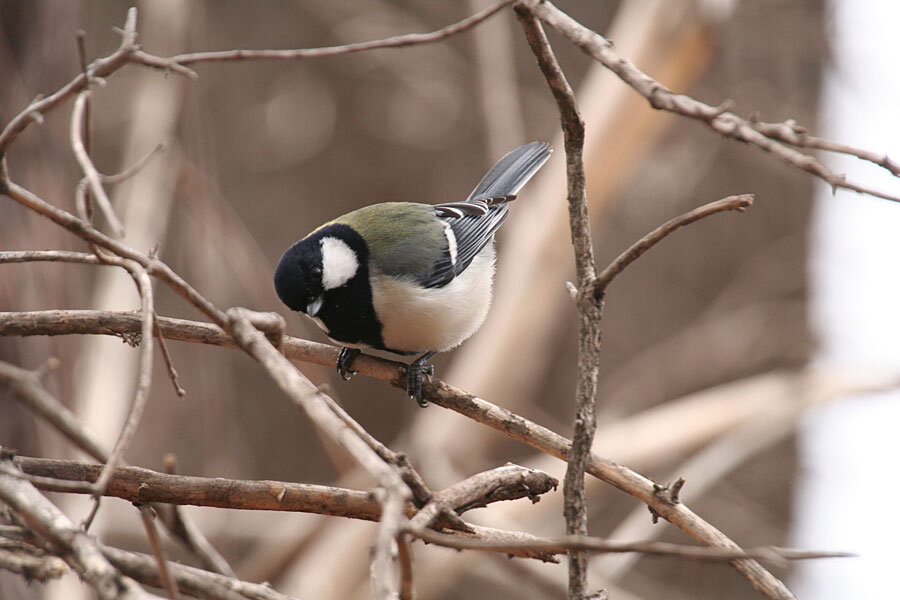Chirps with syntax: Do bird calls work like human language?
Loading...
Birds may communicate surprisingly like humans.
In human language, the combination and order of words helps shape the meaning of a sentence. And bird calls may use similar structure.
Compositional syntax, combining different words to communicate a compound meaning, was thought to be unique to human language. But Japanese great tits, particularly vocal songbirds, also use compositional syntax in their bird calls, according to a new study published Tuesday in the journal Nature Communications.
"Our study shows, for the first time, that birds, like humans, use the rules of syntax to chat with others. This finding reveals an unsuspected degree of semantic complexity in avian vocal communication," study lead author Toshitaka N. Suzuki, says in an email to The Christian Science Monitor.
Birds twitter, chirp, peep, warble, and sing to communicate the location of a food source, to warn that danger is near, or to woo mates. But how exactly do birds vocalize particular complex meanings?
Dr. Suzuki and his colleagues had noticed the Japanese great tit using different sounds and different combinations of sounds in a variety of contexts. "We wondered if these calls, like human language, are comprised of different elements with distinct meanings," he says.
Great tits are in the same family as chickadees and produce calls that are similarly structurally complex. So the researchers listened and broke down the great tits' calls into notes to better understand how they were used individually and together in a string.
Note types dubbed A, B, C, and D are used together to form calls. The team observed that A, B, C notes are usually used in combination with others, so a call would be AB, BC, or ABC. But D notes were often in a string of seven to 10 notes forming a call, DDDDDDD.
To understand the calls' meanings, the team observed how the birds responded to hearing certain recorded calls projected over a loudspeaker. Birds hearing an ABC call would scan the horizon looking for a predator or some other danger. And a D call triggers the bird to move toward the source of the call, perhaps having been told to come find a food source or join a mate in their nest.
The researchers hypothesized that combining the two calls into ABC-D would produce a compound meaning, and demonstrate compositional syntax. And they were right. When the birds heard an ABC-D call, they simultaneously scanned the horizon and moved toward the sound.
But the birds could have simply been responding to both calls separately rather than as a compound unit. So the researchers reversed the calls, forming a D-ABC unit, to see if the birds reacted in the same way.
They found that the order matters.
When the researchers played a D-ABC call, the great tits rarely scanned the horizon or approached the sound. "These findings demonstrate that Japanese great tits have evolved compositional syntax by which different meanings are combined into a compound meaning through a note-ordering rule," Suzuki says.
And this demonstrates that "compositional syntax is not unique to human language but may have evolved independently in animals as one of the basic mechanisms of information transmission," he says.
But "there is no indication the Japanese great tits produce a D-ABC call. They may be responding to the D-ABC playbacks simply because they sound novel or highly atypical, and not because they recognize a syntax violation," cautions Todd M. Freeberg, who studies animal communication at The University of Tennessee - Knoxville but was not part of this study, in an email to the Monitor.
"Hopefully one day we can find a parid (chickadees, tits, titmice) species that naturally produces something like ABCD and BCAD (for example) variations in its day-to-day calling behavior. Then, if experimental playbacks were to reveal that birds responded to ABCD playbacks differently than they did to BCAD playbacks, that would go a much longer way toward a convincing argument about compositional syntax!" Dr. Freeberg writes.
But, he adds, "The study provides clear and convincing evidence that these birds are paying attention to the ways in which specific combinations of notes are put together in these calls."
Although the tweeting birds don't sound like much to the untrained ear, they could be quite advanced communicators if they are using compositional syntax.
"The compositional syntax serves to increase the number of meanings that are conveyed by an individual at the same time," says Suzuki. "Thus, our findings suggest that bird calls may contain more complex information than previously considered."
Not only are these birds adept communicators, compositional syntax has yet to be observed in any other nonhuman animal.
"Birds have quite a complex communication system, so you can find out a lot about what nonhuman animals are capable of by looking at birds," William A. Searcy, a behavioral ecologist and animal communication researcher at the University of Miami who was not part of the study, tells the Monitor in a phone interview.
And bird calls could even tell us something about the evolution of our own use of language.
"If you find syntax in a bird, you can't claim that that's a precursor to syntax in human languages because birds clearly aren't ancestral," Dr. Searcy says. But "it does provide a possible model for the first steps in the evolution of human syntax."






